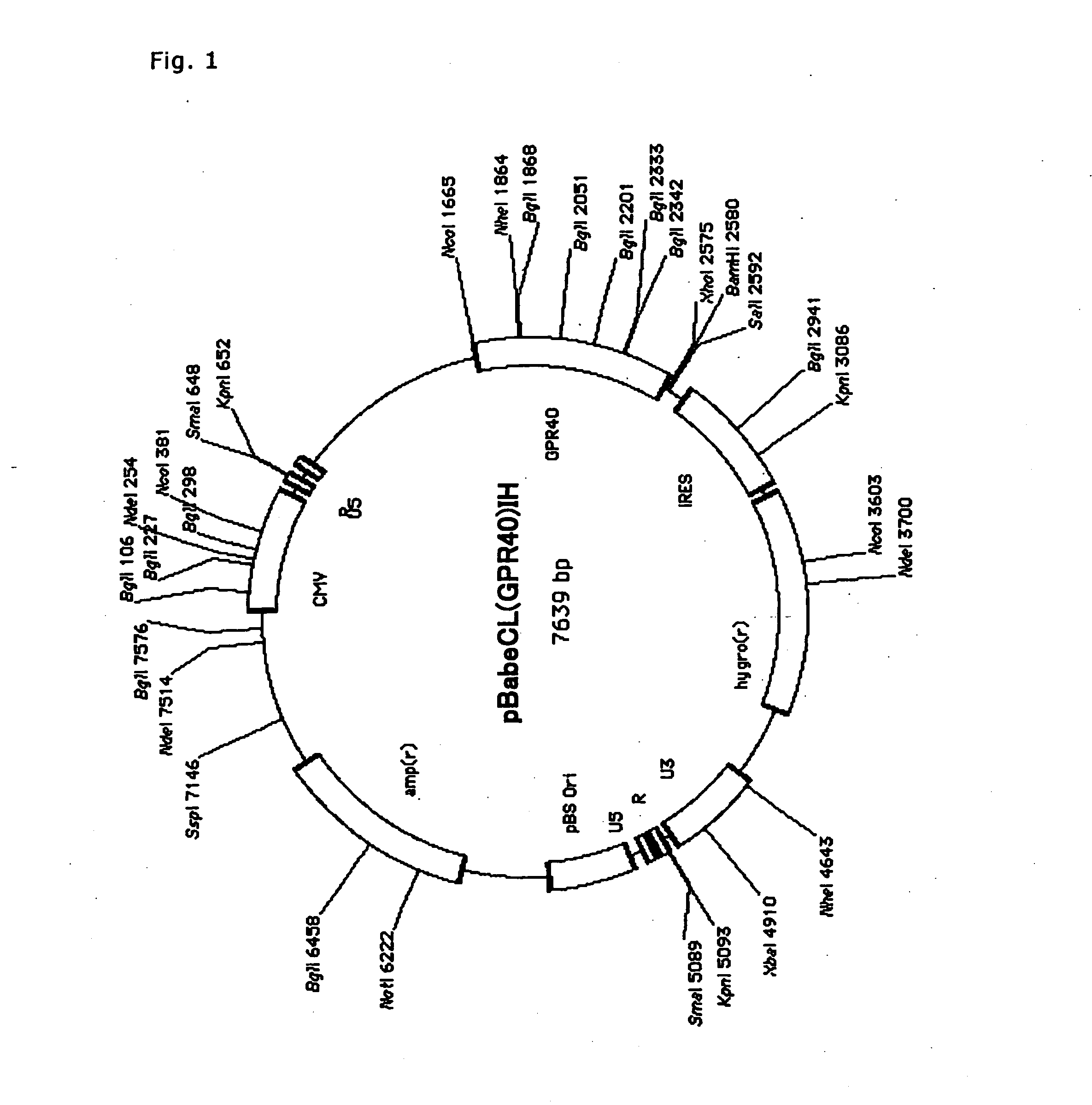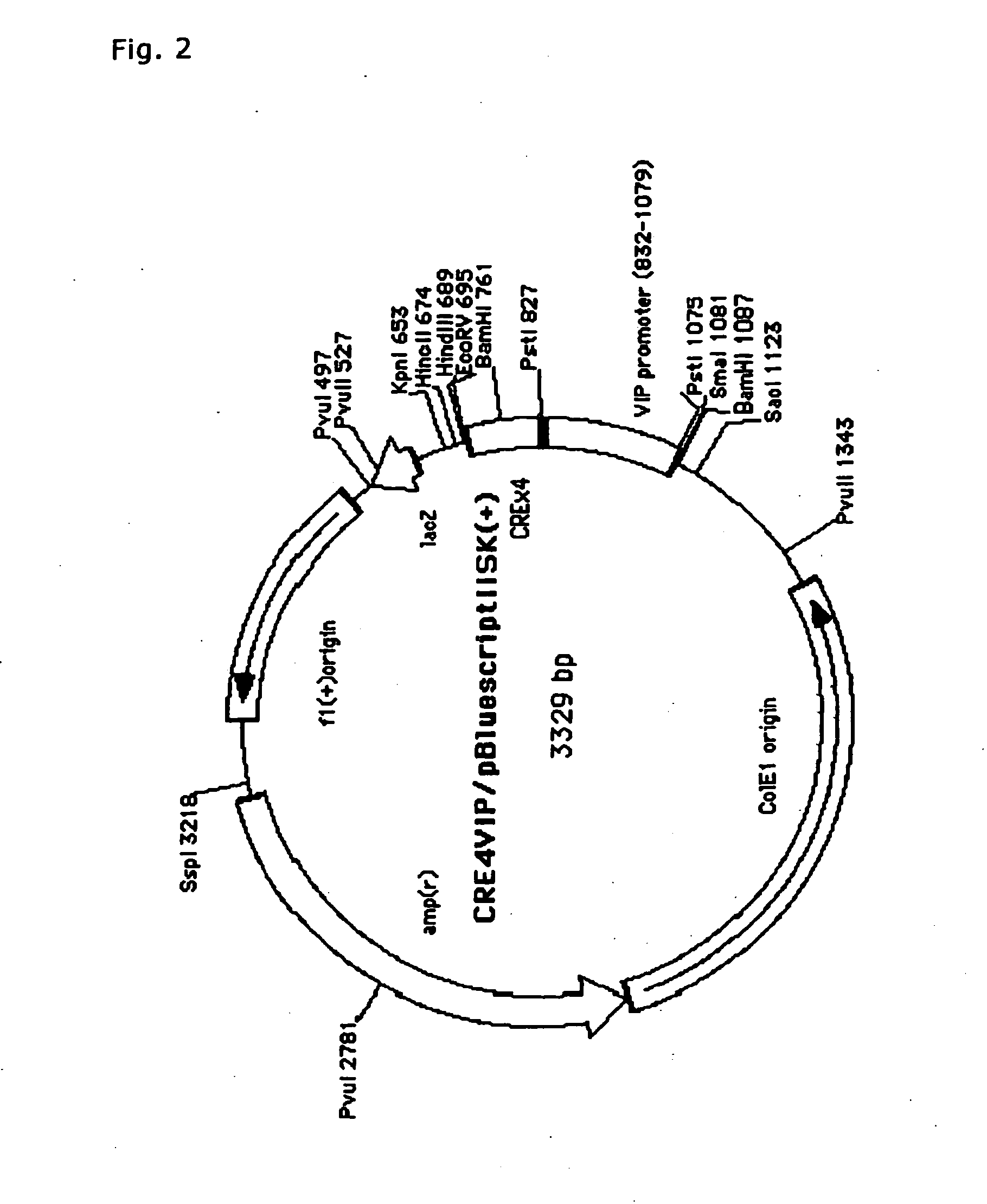Method of Screening Substance Useful in Treating Disease With the Use of GPR40 and Phospholipase
a screening substance and phospholipase technology, applied in the field of screening substances useful in treating diseases with the use of gpr40 and phospholipase, can solve the problems of difficult prediction of the type of signal transduction system activated by orphan gpcr after responding to a ligand, difficult to predict the ligand for each of orphan gpcrs, and difficult to predict the type of signal transduction system in which a ligand is
- Summary
- Abstract
- Description
- Claims
- Application Information
AI Technical Summary
Benefits of technology
Problems solved by technology
Method used
Image
Examples
example 1
Preparation of a Polynucleotide Encoding GPR40
[0181]In order to isolate a polynucleotide encoding human GPR40 (optionally referred simply to as GPR40 or hGPR40 hereinafter), PCR primers, a 5′-primer (5′-ttgatatcgccgccaccatggacctgcccccgcagct-3′) (SEQ ID NO: 19) and a 3′-primer (5′ -ttacttctgggacttgccccctt-3′) (SEQ ID NO: 20), were designed based on the 903 by nucleic acid sequence of SEQ ID NO: 1 according to an ordinary method. PCR was carried out at 94° C. for 5 min followed by repeating 35 cycles of reaction at 94° C. for 1 min, at 58° C. for 2 min, and at 72° C. for 1 min, with a final elongation reaction at 72° C. for 7 min using Human Pancreas QUICK-Clone™ cDNA (Clontech Company) as a template, the PCR primers consisting of SEQ ID NO: 19 and SEQ ID NO: 20, and Expand High Fidelity PCR System (Roche Diagnostics K.K.). The amplified PCR product was inserted into pCR2.1 (Invitrogen Corporation) and the sequence was confirmed using the ABI prism DNA sequencing kit (Perkin-Elmer App...
example 2
Preparation of a Retrovirus Vector Plasmid
[0182]The SV40 promoter-puro(r) region was removed by cleaving pBabe Puro (Morgenstern, J. P. and Land, H. Nucleic Acid Res. 18(12):3587-96, 1990) (SEQ ID NO: 21) with SalI and ClaI, and the terminals were then blunted using Klenow fragment (Takara Shuzo, Co., Ltd.). Into this site, the IRES-hyg(r) region excised from pIREShyg (Clontech Company) by cleavage with NsiI and XbaI and blunted with T4 polymerase (Takara Shuzo, Co., Ltd.) was inserted to obtain pBabeXIH.
[0183]This pBabeXIH was cleaved with SspI and BamHI and the 5′-LTR-packaging signal was removed. Into this site, the 5′-LTR-CMV promoter-packaging signal excised from pCLXSN (IMGENEX, Co.) by cleavage with SspI and BamHI was inserted to obtain pBabeCLXIH.
example 3
Preparation of a Retrovirus Vector Plasmid for Introduction of Gpr40 Gene
[0184]The retrovirus expression plasmid obtained in Example 2, pBabeCLXIH, was cleaved with a restriction enzyme, HpaI. Into this site, cDNA encoding GPR40 excised from the GPR40-pCR2.1 obtained in Example 1 by cleavage with EcoRV was inserted to obtain pBabeCL (GPR40)IH (FIG. 1).
PUM
| Property | Measurement | Unit |
|---|---|---|
| temperature | aaaaa | aaaaa |
| temperature | aaaaa | aaaaa |
| temperature | aaaaa | aaaaa |
Abstract
Description
Claims
Application Information
 Login to View More
Login to View More - R&D
- Intellectual Property
- Life Sciences
- Materials
- Tech Scout
- Unparalleled Data Quality
- Higher Quality Content
- 60% Fewer Hallucinations
Browse by: Latest US Patents, China's latest patents, Technical Efficacy Thesaurus, Application Domain, Technology Topic, Popular Technical Reports.
© 2025 PatSnap. All rights reserved.Legal|Privacy policy|Modern Slavery Act Transparency Statement|Sitemap|About US| Contact US: help@patsnap.com



